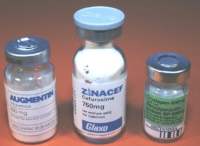 Hurricane Maria ravaged Puerto Rico almost 3 months ago, destroying factories that manufacture and distribute medications and related supplies. Healthcare facilities across the nation are now experiencing a critical shortage of small-volume intravenous (IV) fluids, which impacts the supply of IV antimicrobials. With no end in sight, ED providers can protect the quality of patient care by considering 2 strategies: IV to PO conversion and first-dose antimicrobials via IV push.
Hurricane Maria ravaged Puerto Rico almost 3 months ago, destroying factories that manufacture and distribute medications and related supplies. Healthcare facilities across the nation are now experiencing a critical shortage of small-volume intravenous (IV) fluids, which impacts the supply of IV antimicrobials. With no end in sight, ED providers can protect the quality of patient care by considering 2 strategies: IV to PO conversion and first-dose antimicrobials via IV push.
IV to PO: What You Should Know
Every healthcare team member has a role in IV to PO stewardship. Clinicians should consider if a PO medication is equally effective prior to prescribing an IV therapy. Pharmacists can make PO recommendations during order verification. Nurses can consider a patient’s ability to tolerate a PO medication. Patient education is also crucial as some patients expect IV therapies when in an ED.
Some diagnoses warrant empiric IV antibiotics, and a there is no clinically appropriate PO alternative. Examples (not a complete list) include:
- Meningitis
- Endocarditis
- Severe intra-abdominal infections
- High-risk neutropenic fever
- History of multi-drug resistant organisms with no PO antibiotic options
Additionally, the following situations generally exclude patients from receiving PO medications:
- Hemodynamically instability
- Severe vomiting or diarrhea within past 24 hours
- Non-functional GI tract (e.g. obstruction, malabsorption, or bleed)
- Aspiration risk (e.g. altered mental status or impaired swallowing apparatus)
- Patient is not tolerating at least a clear liquid diet or tube feeds
- Medication cannot be administered through a feeding tube
That being said, it is possible to treat certain infections with PO medications from the start of a patient’s ED course such as:
- Urinary tract infections
- Certain skin and soft tissue infections
- Low-risk community-acquired pneumonia
Anecdotally, these are the “big 3” common offenders of empiric IV antibiotics in the ED when a PO alternative is often appropriate. For example, IV azithromycin is typically diluted to a concentration of 2 mg/mL (500 mg in 250 mL bag) and infused over 30-60 minutes. The PO tablet, however, is absorbed rapidly from the GI tract and distributed to the lung. Not only would PO treatment conserve IV fluids, but it would reduce ED length of stay.
Other potential benefits of IV to PO conversion include:
- Decreasing the risk of infection via IV placement
- Decreasing the risk of phlebitis
- Promoting patient comfort
- Promoting early ambulation
- Decreasing nursing workload
When IV Equals PO
These antimicrobials have excellent absorption and/or bioavailability and are efficacious independent of enteral or parenteral route:1
| * Reduced at high pH
^ Sulfamethoxazole/Trimethoprim |
|
| Antimicrobial | Bioavailability |
|---|---|
| Azithromycin | 34-52% |
| Clindamycin | ~90% |
| Ciprofloxacin | 50-85% |
| Doxycycline | >90%* |
| Fluconazole | >90% |
| Isavuconazole | 98% |
| Levofloxacin | 99% |
| Linezolid | ~100% |
| Metronidazole | >95% |
| Moxifloxacin | 90% |
| Rifampin | >90% |
| TMP/SMX^ | 90-100% |
| Voriconazole | 96% |
To Push or Not To Push
IV push antibiotic administration eliminates the need for small-volume IV fluids and reduces time to administration. Antimicrobials that are safe to administer via IV push are typically those with low osmolality and minimal rates of injection-related phlebitis. A trick of the trade for IV push antibiotics has been previously described on EM:RAP (subscription podcast), and we expand on the previously published table below.2–9
Note: it is important to reconstitute these antimicrobials in sterile water for injection (SWFI) to minimize osmolality. Reconstitution with NS or D5W may cause significant phlebitis.
| Antimicrobial |
Reconstitution or Concentration |
IV Push Rate |
| Aztreonam | 1 g + 10 mL SWFI | 3-5 minutes |
| Cefazolin | 1 g + 10 mL SWFI | 3 minutes |
| Cefepime | 1 g + 10 mL SWFI
2 g + 10-20 mL SWFI |
3 minutes |
| Cefotetan | 1 g + 10 mL SWFI | 3 minutes |
| Cefoxitin | 1 g + 10 mL SWFI | 3 minutes |
| Ceftazidime | 1 g + 10 mL SWFI | 3 minutes |
| Ceftriaxone | 1 g + 10 mL SWFI
2 g + 20 mL SWFI |
3 minutes |
| Cefuroxime | 1.5 g + 20 mL SWFI | 3 minutes |
| Daptomycin | 500 mg + 10 mL SWFI | 2 minutes |
| Ertapenem | 1 g + 10 mL SWFI | 5 minutes |
| Gentamicin | 40 mg/mL | 3 minutes |
| Meropenem | 500 mg vial + 10 mL SWFI
1 g + 20 mL SWFI |
3-5 minutes |
| Tobramycin | 40 mg/mL | 3 minutes |
Special Case: Beta-Lactam Antibiotics
Although the ED is an ideal environment for many IV push antibiotics, the bactericidal activity of beta-lactams is more time-dependent than concentration. This means that the most appropriate dosing strategy for this drug class maximizes the duration of antibiotic exposure.
A recent systematic review and meta-analysis that included 3,401 patients receiving piperacillin/tazobactam therapy found that a prolonged infusion was associated with decreased mortality and improved clinical cure when compared to intermittent dosing.10 Therefore, it is reasonable to limit IV push administration of beta-lactam antibiotics to first doses in the ED. Fluid conservation efforts can continue by preparing subsequent doses as concentrated solutions in 20-60 mL syringes and using syringe pumps for prolonged infusions. Additionally, some beta-lactams can be compounded in large-volume IV fluids and administered as continuous infusions.
Final Thoughts
There are potential silver linings during critical medication and IV fluid shortages, including the opportunities to:
- Highlight treatment practices for which there is minimal supportive data
- Study the clinical and operational outcomes of alternative treatment strategies
- Gain experience using other effective medications (e.g. ketamine during previous etomidate shortage)
- Provide team-based care, working closely with nurses and pharmacists to select patients best suited for PO therapies
Final note: Be sure to thank your nurses, pharmacy technicians, central pharmacists, information technology specialists, administrators, and others who are instrumental in operationalizing drug shortage efforts!
Updated 12/15/17 to include oral Sulfamethoxazole/Trimethoprim use.
Author information
The post Strategies for Surviving the IV Fluid Shortage: Antibiotic IV to PO Conversions & First Dose via IV Push appeared first on ALiEM.

